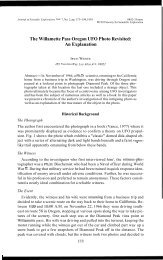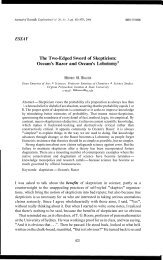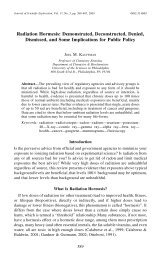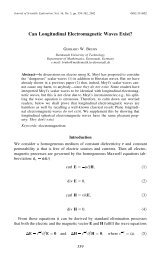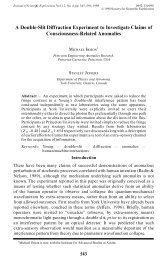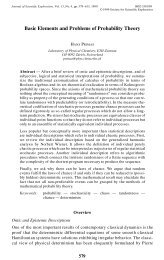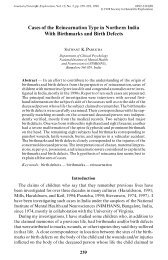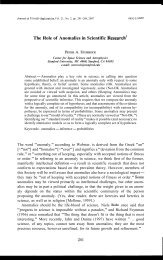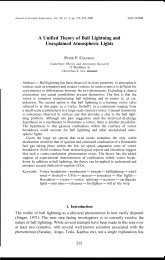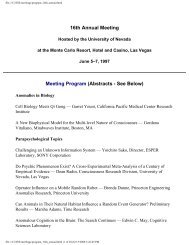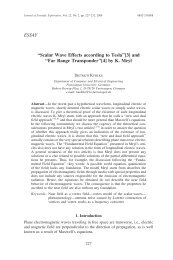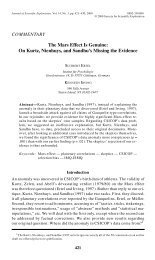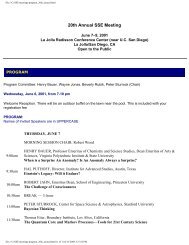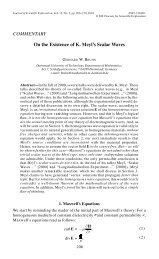REVIEW ARTICLE Ufology: What Have We Learned? - Society for ...
REVIEW ARTICLE Ufology: What Have We Learned? - Society for ...
REVIEW ARTICLE Ufology: What Have We Learned? - Society for ...
Create successful ePaper yourself
Turn your PDF publications into a flip-book with our unique Google optimized e-Paper software.
546 M. D. Swords<br />
encounters in both the European and Pacific theatres of war. There began about<br />
ten years wherein the investigation of the phenomenon was almost entirely<br />
a military and/or intelligence activity (1945-1955). Following that, the interested<br />
civilians began creating (often very active) organizations, such as:<br />
Donald Keyhoe's National Investigation Committee on Aerial Phenomena<br />
(NICAP), the Lorenzen's Aerial Phenomena Research Organization (APRO),<br />
and the flagship UFO magazine, Flying Saucer Review (FSR). It was these<br />
elements (and strong-willed personages) that kept serious interest in the subject<br />
alive during a time of severe attacks in the <strong>for</strong>m of derisive commentary by<br />
government officials, the media, and a few scientists. NICAP, APRO, FSR,<br />
et al., persisted through all of this buttressed by what some researchers call the<br />
heyday of classic ufology: 25 years filled with a large number and variety of<br />
"Close Encounter" cases, involving high quality and multiple independent<br />
witnesses, and incidents of physical effects. Although the Air Force's Project<br />
Blue Book closed in the middle of this period, civilian organizations such as<br />
Dr. J. Allen Hynek's Center <strong>for</strong> UFO Studies (CUFOS) and the Mutual UFO<br />
Network (MUFON) arose to carry on the battle (Figure 1). During this time<br />
(1955-1980), the phenomenon seemed to shift its emphasis from metallic disks<br />
cruising across the skies and lighting up radar screens, to close encounters with<br />
"landing traces," electromagnetic intcrfcrence, physiological effects, and<br />
"entity" reports. The "old-style" cases were still around but the new-style<br />
ones offered the hope that laboratory science would be able to be brought to<br />
bear on the subject at last.<br />
But, despite insightful statistical studies, such as those by Dr. David Saunders<br />
(of the Colorado Project), Dr. Claude Poher, and our own SSE colleague,<br />
Dr. Jacques Vallee (in his ChicagoIHynek years), the UFO phenomenon could<br />
not seriously dent the world of mainstream science. Clusters of case types and<br />
analyses by people such as Ted Phillips ("physical ground traces")', and<br />
Dr. Mark Rodeghier ("vehicle interference event^")^ were powerful corroboration<br />
of the physical reality of the phenomenon to those already committed to<br />
the field, but still fell silently in the ears of a nonattentive scientific community<br />
(Figure 2). Doctor Hynek knew that some kind of new approach was necessary.<br />
There<strong>for</strong>e, he founded the Center <strong>for</strong> UFO Studies not with the intent of chasing<br />
down every "good" sounding case that came to his attention, but rather to be<br />
highly selective of cases wherein some physical effect had occurred and its<br />
results were still present after the agent (the UFO) left the scene. These remanent<br />
"leavings" of the phenomenon could then be taken to the laboratories and<br />
hammered with all the science that could be brought to bear. Because most<br />
scientists were still shy on the subject and most high-tech labs were even more<br />
so, Hynek realized that he had limited social capital (and almost no economic<br />
capital) to spend on such testing and felt that one or two evidence-rich cases per<br />
year would be a reasonable goal. As it transpired, CUFOS was able to employ<br />
this strategy on exactly one case: the soil from the "landing trace" case of<br />
Delphos, Kansas, which had occurred in late 197 1.



